Cultural Selection
CUSCO
(INCLUDED)
Below are the activities corresponding to Cusco:
• The ancient Inca Empire of Cusco
• The town of Misminay
• Road to Patabamba
• San Pedro Market
• Village of Andahuaylillas
• Decoding the Andean Textiles
• Hacienda Sarapampa and Giant White Corn
• The Community of Chichubamba
• Paru Paru with Pachamanca lunch
• Pachamama Ceremony
• Lamay Farm and Food
• The astounding town of Lamay
• Chinchero weaving demonstration
Show More
Show Less
.jpg)
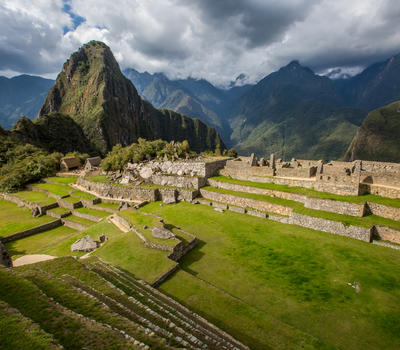
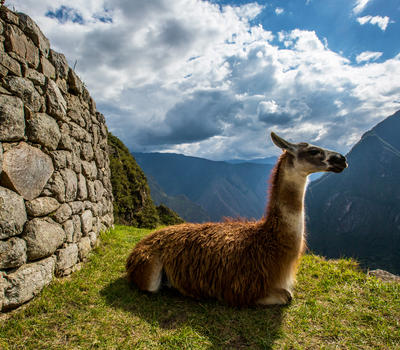
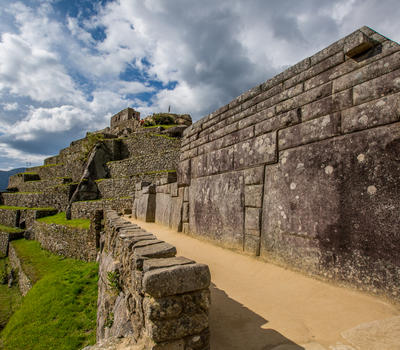
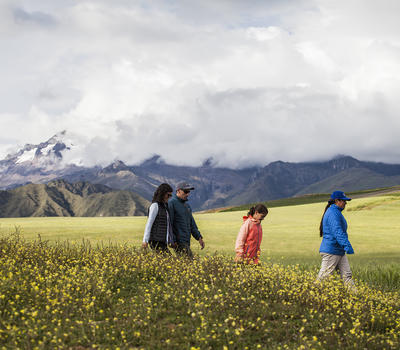

THE ANCIENT INCA EMPIRE OF CUSCO
The city of Cusco was the Navel of the World for the Incas, and the capital of their vast Empire. Known as the archaeological center of the Americas, Cusco was one of the largest and most advanced cities in the New World by the time the Spanish arrived. This vibrant city serves as the gateway to Machu Picchu and the Sacred Valley. Its narrow cobble-stoned streets are still charged with the mysticism and energy that flowed among its people.
The Highlands of Peru
Semi-dry and cold with sunny days.
3,399 masl (11152 feet)
Highlights: Paru Paru, Lamay, Hacienda Sarapampa.
Area: 72 km² (27.79 mi²)
Show More
Show Less
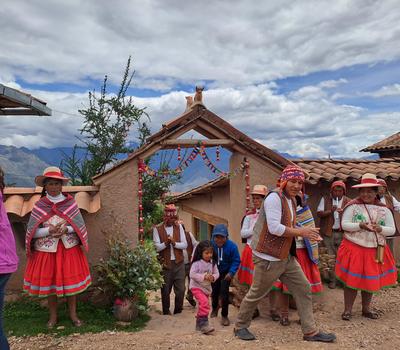
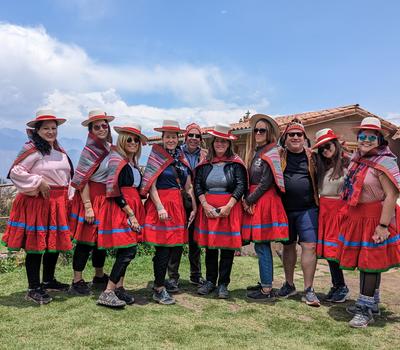
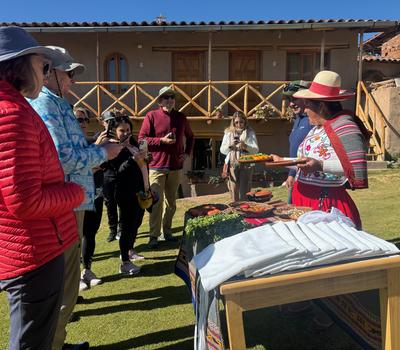
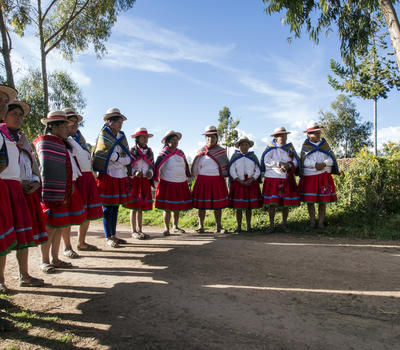
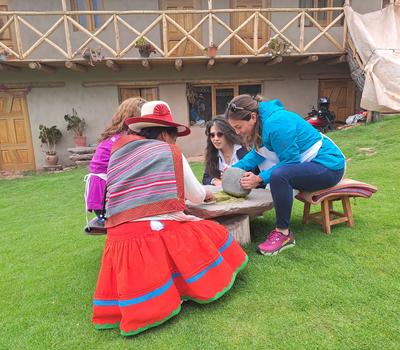
THE TOWN OF MISMINAY
The colorful town of Misminay is ready to welcome you with flowers, music, and dances. Here you can be part of a variety of activities and become part of their community for a day or even two.
Duration: 2 hours
Altitude: 3700 masl (12139 feet)
Access Route:
50 km (31 mi) / 1 hour 34 min by highway (from Cusco)
27 km (17 mi) / 46 min by highway (from Sacred Valley)
Fun for kids
While at Misminay you can walk around their fields with a knowledgeable local who will explain about the different crops and their ancestral techniques. You can also enjoy a textile demonstration and witness the making of beautiful patterns. If you’re feeling hungry then the cooking lessons are for you, learn to make our traditional sauce uchucuta and taste it with different types of potatoes. For those who want a little hiking, you can walk to the Moray lookout from where you will have a wonderful view of the terraces.
Show More
Show Less

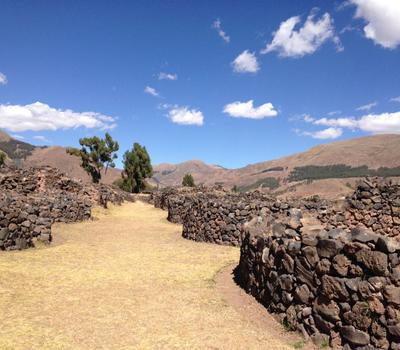
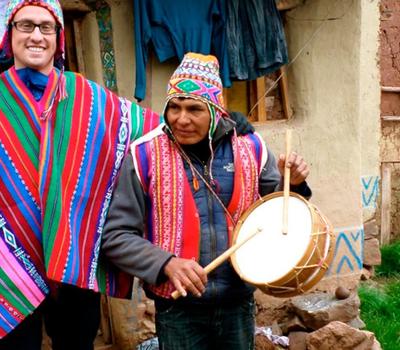


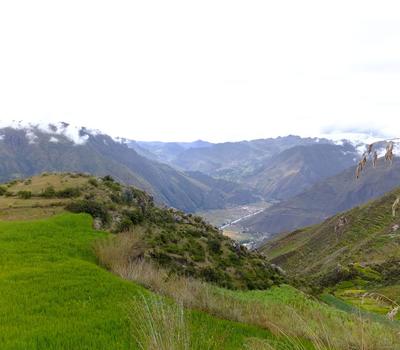
THE ROAD TO PATABAMBA
Between Cusco and the Sacred Valley, the town of Patabamba invites you to experience a journey through a village of approximately 200 families. The town is known as “The balcony of the Sacred Valley” because of its.
Duration: 2 days / 1 night
Altitude: 3800 masl (12467 feet)
Access Route:
42 km (26 miles) / 1 hour 4 min by highway (from Cusco)
27 km (17 miles) / 40 min by highway (from Cusco)
Hike: 5 hours. daily (Difficulty: Hard)
The uphill road to Patabamba is paved over the footprints of the ancient Inca civilizations and it is the entrance to the archaeological remains of Huchuqosqo or, as we would call it in English, little Cusco.
Surrounded by abras and deep canyons, you will make your way through small traditional villages that still breathe culture of their ancestors.
Also, you will become a part of this community by staying overnight in Patabamba town and immersing in their everyday activities and traditions.
Show More
Show Less
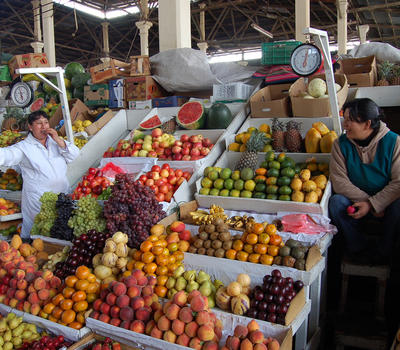
SAN PEDRO MARKET
A place where all your sense come into play. Venture into the colorful San Pedro market and walk through the mystical side of Cusco.
Duration: 2 hours
Altitude: 3700 masl (12139 feet)
Maximum: 20°C (68°F) Minimum: 0°C (32°F)
Access Route:
2 km (1 mi) / 8 min by car (from Cusco)
53 km (33 mi) / 1 hour 20 min (from Sacred Valley)
Among the colorful displays of fruits and local snacks, you'll find unique products from the Peruvian Amazon, including medicinal herbs and traditional ointments.
If you wish you buy souvenirs, this market is also the place to be. With a vast array of textiles, chocolates, ceramics, and jewelry, you’re sure to find the perfect souvenir to take home.
While wondering through its many aisles, make sure to stop and listen to the Quechua speakers and learn a bit more about this millenary language. You can also witness shamans performing cleansing rituals on tourists and locals alike with the power of coca leaves and even some animals.
Show More
Show Less
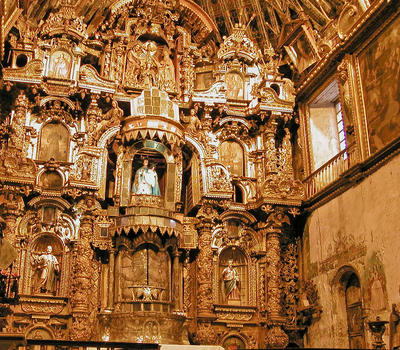
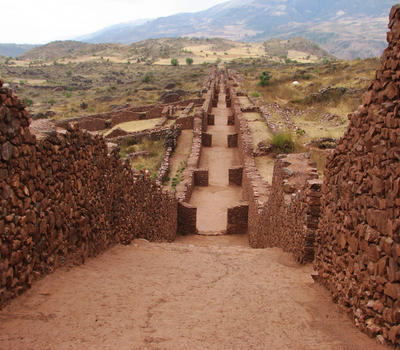
VILLAGE OF ANDAHUAYLILLAS
Andahuaylillas is a very small but special town. Its beautiful Pisonay trees and orange flowers naturally decorate its main square. In the center lies The Church of Saint Peter the Apostle, the reason for this town’s fame.
Duration: 1 hour
Altitude: 3122 masl (10243 feet)
Maximum: 16°C (66°F) Minimum: 0°C (32°F)
Access Route:
40 km (25 mi) / 57 min (from Cusco)
75 km (47 mi) / 1 hour 33 min (from Sacred Valley)
The Church of Saint Peter Apostle is better known as “the Sistine Chapel of the Americas” due to its breathtaking decorations. Built in 1580, it is the main expression of the Andean Baroque, an artistic style inspired in the European Baroque with Andean influence.
The simplicity of its exterior contrasts with its rich interior filled with gilded altars, polychrome ceilings and walls completely covered in murals and paintings.
The Baroque style was impregnated through all the church architecture in an imposing way.
Show More
Show Less
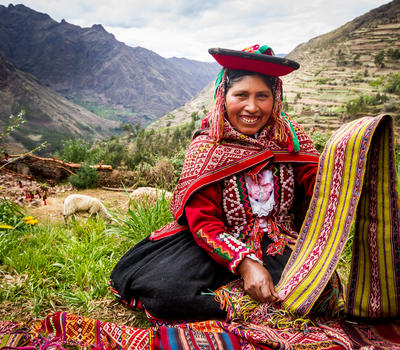
.jpg)
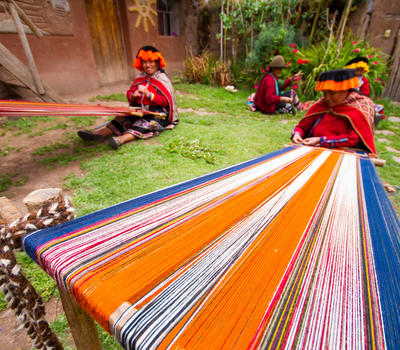
DECODING THE ANDEAN TEXTILES
The vivid colors of the clothing worn by the villages of Amaru come from natural dyes extracted from plants and other organic elements.
Duration: Between 4 or 5 hours
Altitude: 3521 masl (11552 fasl)
Maximum: 22°C (72°F) Minimum: 3°C (37°F)
Access Route:
49 km (30 mi) / 1 hour 26 min (from Cusco)
50 km (31 mi) / 1 hour 17 min (from Sacred Valley)
Fun for kids: From 10 years old
You will be greeted by an amazing community reception with traditional music and beautiful Inca flowers (kantu).
The Amaru villagers will teach you how to tell their stories through textiles as they help you build your own design.
After the welcoming ceremony, you will begin the activity with an explanation of all the different organic materials used to make the natural dyes.
Our second activity consists of shearing, cleaning and the coiling of the sheep or alpaca wool that is used in textiles, followed by a demonstration of how the wool is dyed by boiling. The iconography that is used in the textiles is extremely important to the villagers of Amaru.
Show More
Show Less
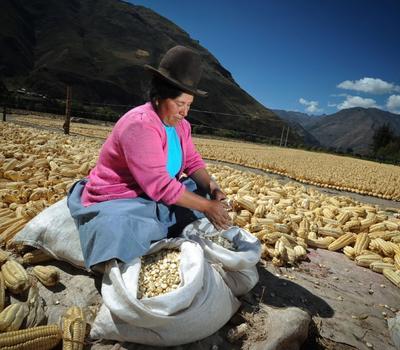
.jpg)
.jpg)
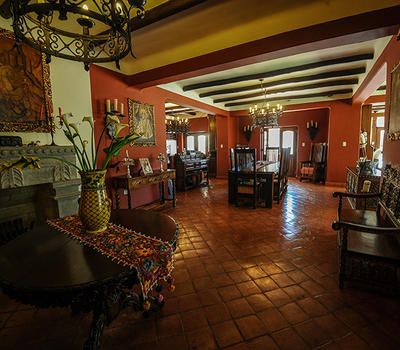
.jpg)
HACIENDA SARAPAMPA
Hacienda Sarapampa is a vivid expression of the culture of corn farming from its beginnings in ancient Peru until today. It offers visitors the opportunity to have a unique experience around traditions in an authentic and natural environment.
Duration: 2:30 hours (or less)
Altitude: 2970 masl (9744 feet)
Maximum: 21°C (70°F) Minimum: 2°C (36°F)
Access Route:
37 km (23 mi) / 1 hour 3 min (from Cusco)
33 km (20 mi) / 54 min (from Sacred Valley)
“Sarapampa” is a word from the Quechua language meaning “cornfield.” The variety of corn grown is the Giant White Corn (mote), a unique variety in the world due to its exceptional characteristics and size.
Cultivated since ancient times, this corn has adapted to the unique conditions of the valley in such way that it only grows there, protected by the mountains and their spirits.
In Hacienda Sarapampa, you will learn how corn influenced the Andeans and those who followed during colonial and recent times. It is relevant to mention that this incredible crop has great importance in the economy of the Sacred Valley of the Incas and its farmers.
Show More
Show Less
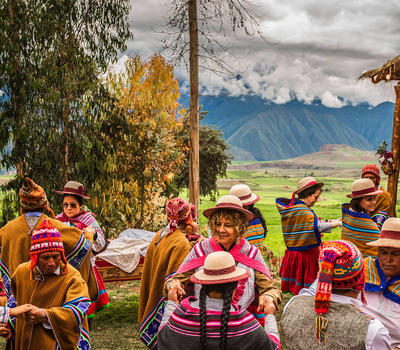
THE COMMUNITY OF CHICHUBAMBA
Welcome to a village of approximately 180 families, a community surrounded by a fantastic green countryside. Delight yourself with the exploration of the everyday life in the town of Chichubamba.
Duration: 5 hours
Altitude: 2881 masl (9452 fasl)
Maximum: 20°C (68°F) Minimum: 1°C (34°F)
Access Route:
5 km (3 miles)
11 min by highway (from Sacred Valley)
Very close to Urubamba, you will find a town that has been blessed by nature. With perfect weather, the inhabitants of Chichubamba have learned to master ancient techniques of beekeeping, chocolate making, and ceramics.
In this journey you will be able to witness these techniques and perhaps even have the chance to bea part of them.
Savor the flavors of the Andes with a delectable lunch prepared by the inhabitants of the Chichubamba lands.
Show More
Show Less

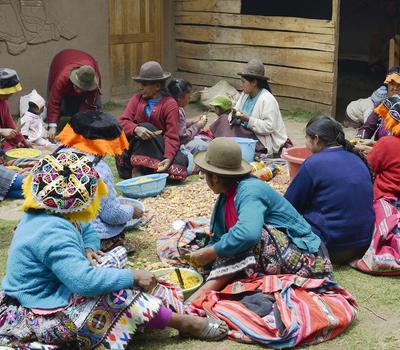
PARU PARU WITH PACHAMANCA LUNCH
A traditional Andean welcome and music will greet you upon your arrival to the Paru Paru community. The inhabitants will tell you more about the Potato Park, which is considered Indigenous Bio Cultural Heritage.
Duration: 7 hours
Altitude: 4200 masl (13780 fasl)
Maximum: 20°C (68°F) Minimum: 0°C (32°F)
Access Route:
52 km (32 miles)
1:20 hours by highway (from Sacred Valley)
Then the collective of Women of Medicinal Plants “Sipas Warmi” will explain the use of native medicinal plants in the zone. After that, you will go towards the Kinsa Q’ocha lagoon, where you will learn about the adaptation of native potatoes and be able to taste these potatoes with a diversity of peppers.
The visit continues to the community of Pampallacta where you will see the seed bank and learn how the seeds are stored and how they are redistributed. Furthermore, you will be able to appreciate the pre-Hispanic textile crafts.
Finally, you will arrive to the community of Chawaytire, there you will learn their traditions, culture and culinary creativity. You will taste the traditional and typical peruvian dish “Pachamanca”.
Show More
Show Less
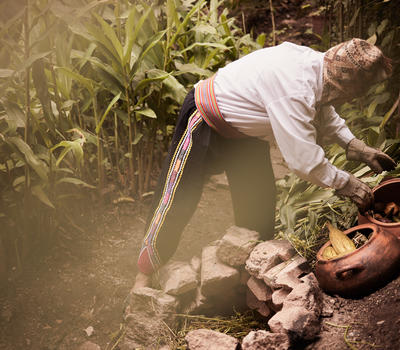
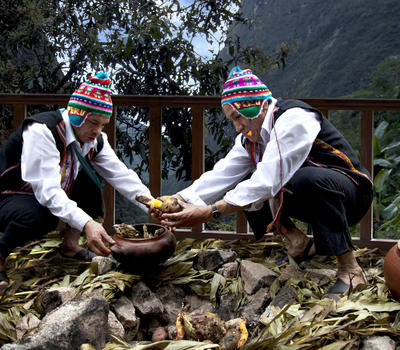
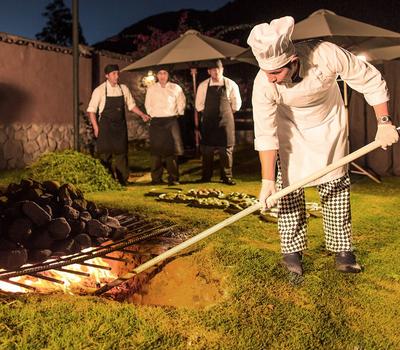

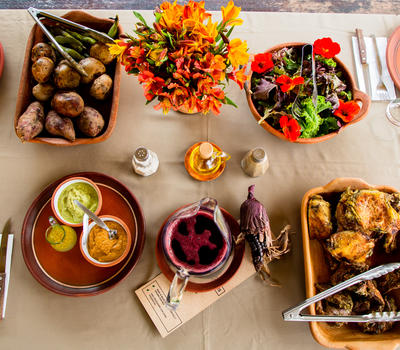
PACHAMANCA CEREMONY
Experience the mysticism and culture of a Pachamama ceremony, an ancient ritual honoring Mother Earth. Led by a traditional 'Pako' or Andean shaman, this experience will connect you with nature in an unforgettable way.
Duration: 1 hour
Altitude: 2800 masl (9186 fasl)
Maximum: 22°C (72°F) Minimum: 6°C (43°F)
* The location should be coordinated in advance.
* It could be arrange in Sacred Valley or Cusco.
During the ceremony, you will prepare and offer small gifts to Pachamama – Mother Earth, including flowers, grains and candies. Offerings are prepared by the shaman according to your intentions.
Pray through the coca leaves for a happy destiny, reaching your hands out and being thankful for everything you have received.
Ask Pachamama for her blessings of health and prosperity, as the powerful natural energy of the nearby glaciers and peaks fill you with vitality.
This ancient tradition has been practiced in the Andes since pre-Inca times.
Show More
Show Less
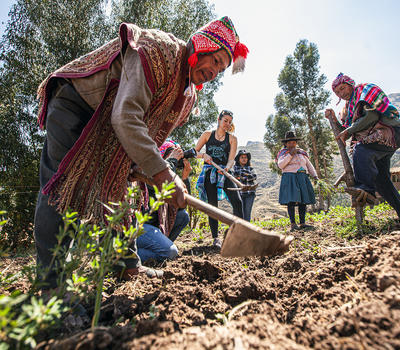
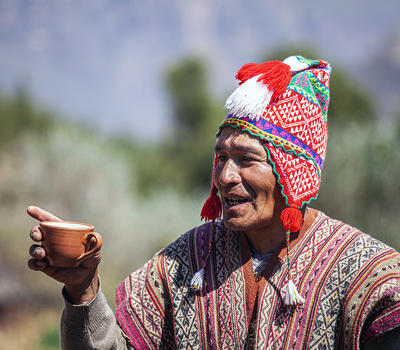
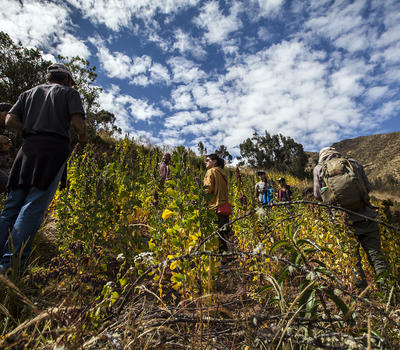
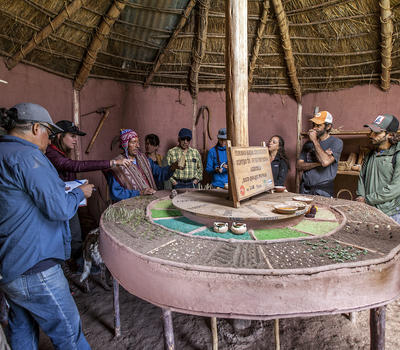
LAMAY FARM AND FOOD
As the breadbasket of the powerful Inca Empire, the Sacred Valley has always been recognized by its vast agricultural resources and biodiversity. In this adventure, you will be able to acquire knowledge on their produce and put it into test in a cooking class.
Duration: 6 hours
Altitude: 2491 masl (9649 fasl)
Maximum: 24°C (75°F) Minimum: 3°C (37°F)
Access Route:
23 km (14 miles)
31 min by highway (from Sacred Valley)
The day will start by leaving Lamay towards the community of Huayllafara. There you will visit some traditional crop farms and try some of the local products such as corn, potatoes, oca, tarwi, quinoa, and beans.
Local farmers will spontaneously guide you on their farmland where you can be part of their daily activities which will depend on the time of year and the agricultural calendar.
There, you will also witness ancestral farming techniques and the processing of food products, such as the preparation of chuño and moraya, the use of quinoa, and the elaboration of chicha de jora. After the activity, you will return to Lamay Base, for the cooking classes to prepare classic peruvian recipes, and the famous pisco sour drink.
Show More
Show Less
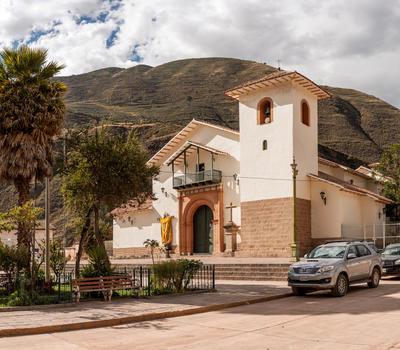
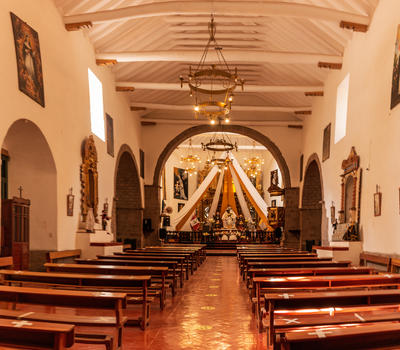
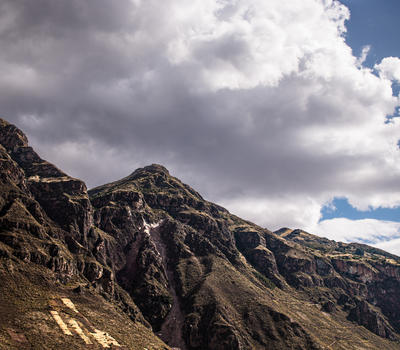
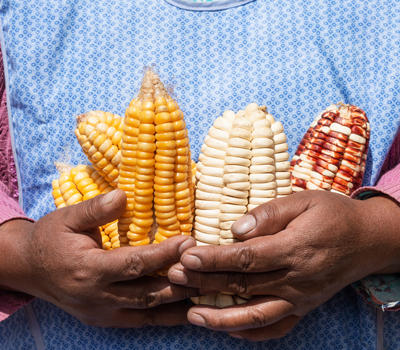
THE ASTOUNDING TOWN OF LAMAY
Be a part of the radiant town of Lamay and learn more about its traditions, history, and daily activities in this journey through the mysticism of unbelievable landscapes.
Duration: 2.5 hours
Altitude: 2491 masl (9649 fasl)
Maximum: 24°C (75°F) Minimum: 3°C (37°F)
Access Route:
23 km (14 miles)
31 min by highway (from Sacred Valley)
Hike: 3km2 (1.86 mi2) / 2.5 hours (Difficulty: Medium)
This adventure begins with a visit to Lamay, a traditional and very little touristic town in the Sacred Valley of the Incas. Arriving at Lamay Base, you will have a brief interpretation of the activities of the town and the agricultural work in the countryside.
Then you will go out to visit some traditional houses and local businesses such as the family guinea pig raising sheds, the traditional “chicherias” where the “chicha de jora” is made, the Pichinku natural dyeing Project, and some other local offers.
Finally, you will return to La Base to have a coffee or a beer and then return to your hotel.
Show More
Show Less
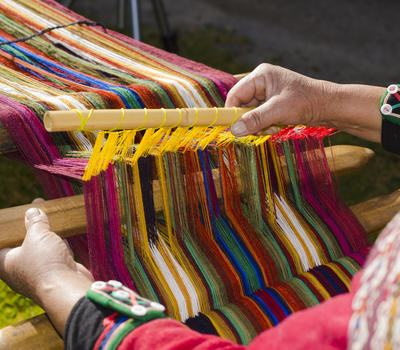
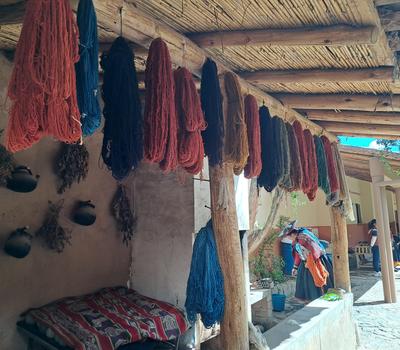
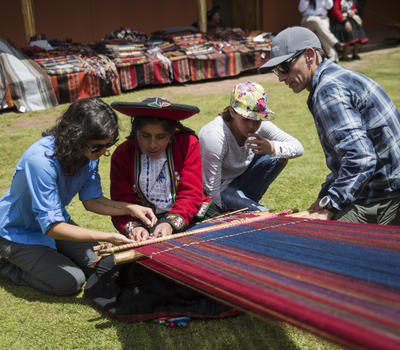
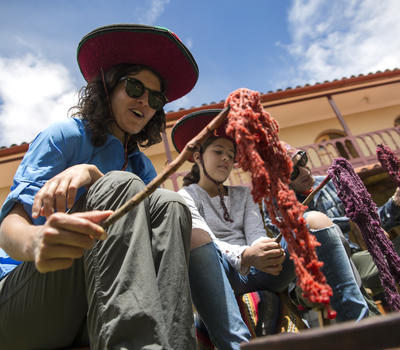
CHINCHERO WEAVING DEMONSTRATION
Chinchero, known as the “Birthplace of the Rainbow”, is a stunning place with incredible ancient weaving techniques which are an important economic activity in the zone. In the weaves, you will also appreciate its colorfulness similar to the rainbow.
Duration: 1 hr (or less)
Altitude: 2772 masl (9094 fasl)
Maximum: 19°C (66°F) Minimum: -3°C (27°F)
Access Route:
30.2 km (19 miles)
48 min by highway (from Cusco)
In this experience, you will visit the home of artist and master weaver Nilda Callañaupa.
Peruvian textiles, recently believed to be a generation away from extinction, are making a surprising comeback, and the revival of the country’s 2,000-year-old weaving techniques is largely due to Nilda Callañaupa, who works with six mountain villages to resurrect symbolic patterns and avoid the use of garish chemical dyes and synthetic yarns.
Enjoy a highly educational weaving demonstration that will include wool spinning, dyes created from natural elements, traditional patterns, and weaving techniques.
Show More
Show Less
LAKE TITICACA
(INCLUDED)
Below are the activities corresponding to Lake Titicaca:
• The cradle of the Inca Empire Lake Titicaca
• The Uros Island
• Amantani Homestay
• Taquile Island
• The Village of Llachon
Show More
Show Less
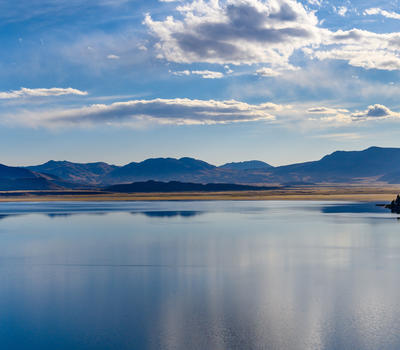
THE CRADLE OF THE INCA EMPIRE LAKE TITICACA
High in the windswept Andes is Lake Titicaca, one of Peru’s most fascinating destinations. Titicaca is the highest navigable lake in the world and the cradle of many legends like the one that gave birth to the Inca Empire.
On its shores, the city of Puno vibrates with dances and festive representations of its people.
Nowadays, the Lake Titicaca still shelters ancient cultures, such as the community of the Uros that inhabits floating islands made of reeds; and the Quechua people who live on Taquile Island and still keep their traditions alive.
The Highlands of Peru
Cold and Semi-dry
3827masl (12556 fasl)
Highlights: Uros Community, Taquile, Virgen de la Candelaria.
Area: 66697 km² (41445 mi²)
Show More
Show Less
.jpg)
-(1).jpeg)
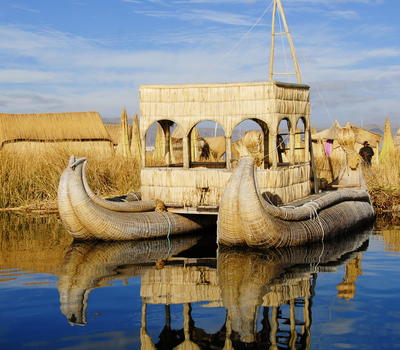
.jpeg)
THE UROS ISLAND
The Uros “Floating Islands” are located on the highest navigable lake in the world, the Titicaca Lake. These more than 90 islands are made of totora reed (aquatic plant) that grows in the lake. The islands are supported by the totora’s dense roots.
Duration: 2 hours
Altitude: 3825 masl (12549 fasl)
Maximum: 14°C (57°F) Minimum: 3°C (37°F)
Access Route:
5 km (3 miles)
20 min by boat (from Puno)
The ancient inhabitants of the lake, known as the “Water Tribe”, built their own islands by periodically adding new layers of the vegetable fiber, which is unique to the area.
The Uros use the totora reed not only to build their islands but also their houses, for cooking, eating, and to sell in the city of Puno, and barter for products such as quinoa, potatoes, barley, and wool.
The community’s main economic activities are fishing, hunting and weaving. On the other hand, they offer immersive journeys, such as the one you will be part of.
Show More
Show Less
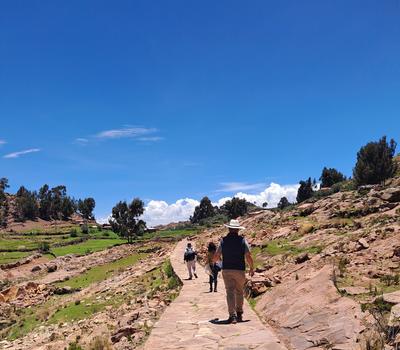
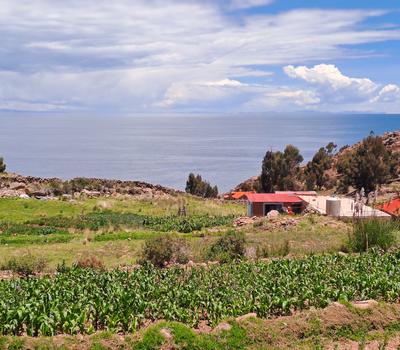
AMANTANI HOMESTAY
Get ready to go back in time with a colorful and vibrant cultural experience. The home of the twin peaks Pachatata (“father earth”) and Pachamama (“mother earth”) open its doors to you.
Duration: 2 days / 1 night
Altitude: 3187 masl (10456 fasl)
Maximum: 18°C (64°F) Minimum: 0°C (32°F)
Access Route:
36 km (22 miles)
3:30 hours by boat (from Puno)
With Inca and Tiwanaku ruins on top of both peaks, the small island is truly a sight to behold.
The hillsides are terraced, mostly worked by hand, and planted with wheat, quinoa, potatoes, and other vegetables. Livestock, including alpacas, also graze the slopes and roam freely amongst the natives and guests.
Spend the night in one of the highest islands in the world, surrounded by walls of adobe, a material used to build houses from ancient times, and which holds the property of keeping the inside warm and safe from the cold weather of the highlands.
Show More
Show Less
.jpeg)
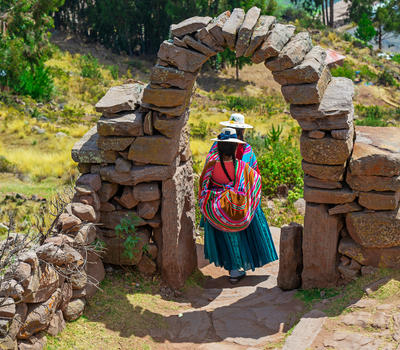
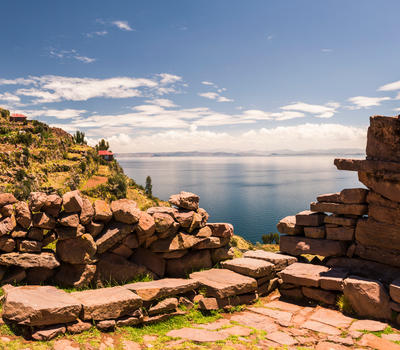
TAQUILE ISLAND
Taquile Island is inhabited by Quechua speaking natives who have developed efficient and unique social systems, as well as fine hand weaving techniques, passed down through generations. Taquile is famous especially for its craft production (declared cultural heritage of humanity) and for its beautiful textiles.
Duration: 3 hours
Altitude: 3927 masl (12883 fasl)
Maximum: 14°C (57°F) Minimum: 3°C (37°F)
Access Route:
36,9 km (22 miles)
3 hours by boat (from Puno)
Hike: 3hours (Difficulty: Medium)
Upon arrival at the Town of Taquile, you will be invited to have lunch served by the owners at one of the local homes.
After lunch, take a walk through the various hills and archaeological sites of this long Island (6 km / 4 mi). There you will find a garden, primary and secondary schools, a health center and also a satellite phone.
Walking around less-visited areas, you will appreciate the pre-Inca temples, tombs and agriculture terraces (built by Pucara culture). Furthermore, you will enjoy its landscapes, traditional farming techniques, and customs like, for example, people wear a special hat to describe both single or married marital status.
Show More
Show Less

THE VILLAGE OF LLACHON
The Village of Llachon is located on the western shore of Lake Titicaca. In this place, you will have the chance to experience the customs and traditions of a local Quechua-speaking community.
Duration: 4 hours
Altitude: 3836 masl (12585 fasl)
Maximum: 14°C (57°F) Minimum: 3°C (37°F)
Access Route:
74 km (46 miles)
1:30 hours by highway (from Puno)
2:00 hours by boat (from Puno)
* If explorers prefer, they could spend the night in the island.
Upon arriving at the Llachon community the families will wait for you and receive you with a warm welcome. You will find the island has been decorated with local materials.
Llachon has become an obligatory stop for visitors to the Lake Titicaca, described as a place where time has stopped, where you will appreciate daily activities of the communities.
In the afternoon, you will share the fishing techniques on Lake Titicaca by navigating in small rowing boats. You will also be able to kayak on the lake for approximately one hour to appreciate villages, farms, and hills of the peninsula and nearby islands.
Show More
Show Less
AREQUIPA & COLCA CANYON
(INCLUDED)
Below are the activities corresponding to Arequipa and Colca Canyon:
• The white city of Arequipa & Colca canyon
• The Village of Coporaque
• Santa Catalina Convent
• Sillar Quarries
Show More
Show Less
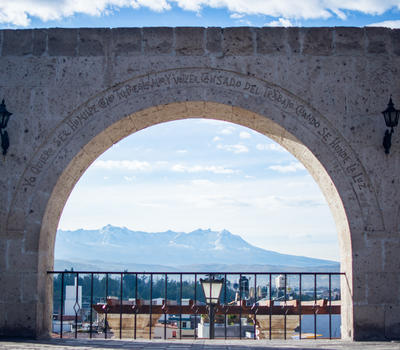
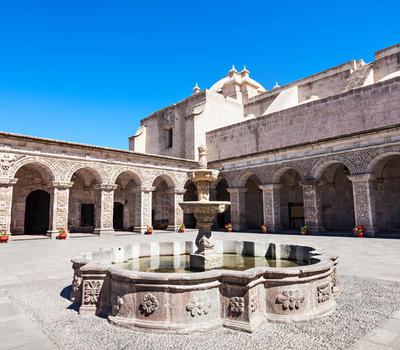
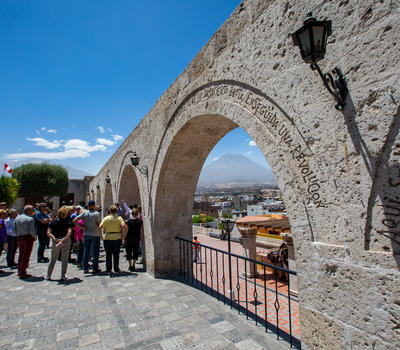
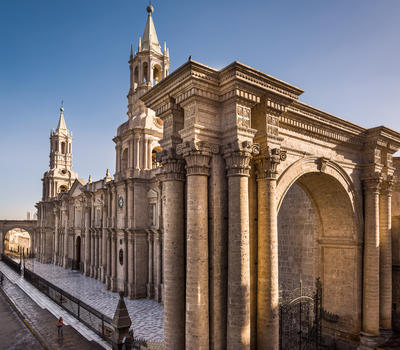
.jpg)
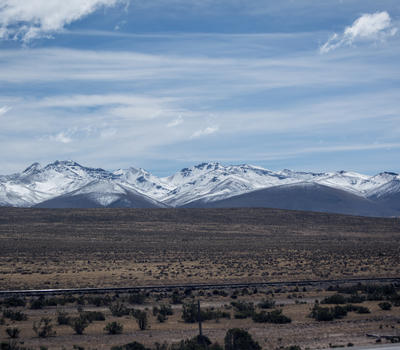
THE WHITE CITY OF AREQUIPA & COLCA CANYON
Arequipa is known as “The white city” because of its white constructions made with volcanic stones. The city not only has beautiful convents, temples and grand old colonial houses, but also holds a wealth of gastronomy as a result of a mixture of native products from ancient Pre-Columbian cultures combined with modern culinary techniques.
Additionally, two of the deepest canyons in the world; the Colca and the Cotahuasi, are the natural habitat of the vicuñas, with the finest fibre in the world, and the condor that shows its majesty when flying a few meters just above guests.
The Highlands of Peru
Semi-arid and temperate.
Maximum Altitude: 4910 masl (16109 fasl)
Minimun Altitude: 9 masl (30 fasl)
Highlights: Coporaque
Area: 63345 km² (39361 miles²)
Show More
Show Less

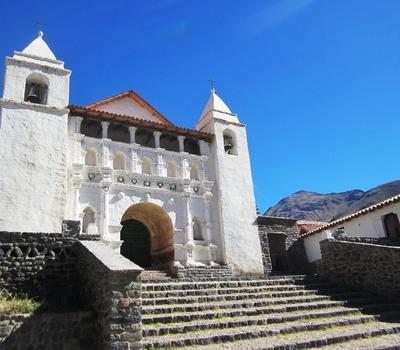
THE VILLAGE OF COPORAQUE
Enjoy an unforgettable journey surrounded by green countryside. This peaceful place has as main economic activities both farming and livestock, and participatory weaving expositions for visitors. If you love nature, Coporaque is the ideal place for you.
Duration: 3 hours
Altitude: 3575 masl (11729 fasl)
Maximum: 21°C (75°F) Minimum: 8°C (46°F)
Access Route:
157 km (98 miles)
10 min by highway (from Colca)
In this experience, you will visit the calm town of Coporaque, where the families who live in the community invite you to their homes to learn more about their daily activities and taste a delicious typical meal.
Share a memorable time with the families and practice activities such as corn selection, cleaning of the quinoa, and much more.
You will also have the option to visit an artisanal center, where you will understand how the famous embroideries of the typical Colca garments and the weaves with alpaca wool are made.
Show More
Show Less
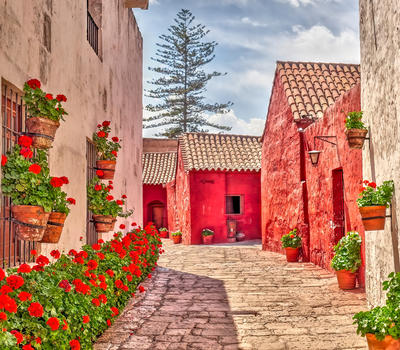
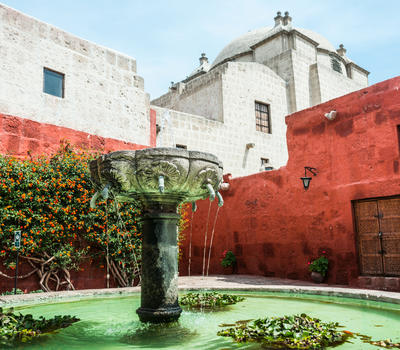
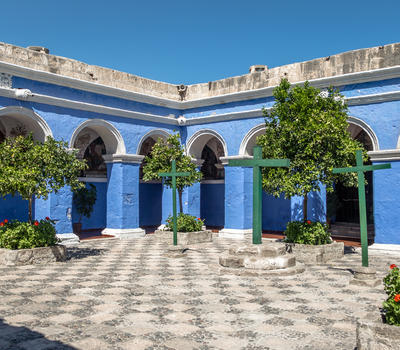
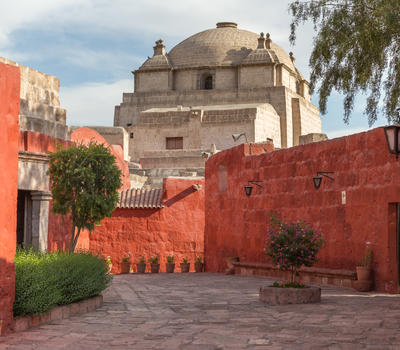
.jpeg)
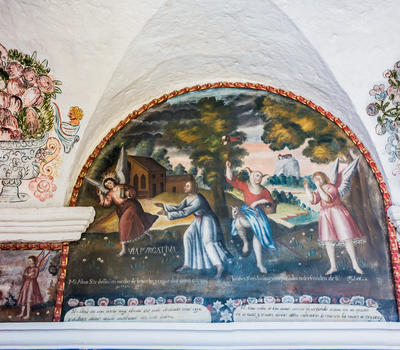
SANTA CATALINA CONVENT
One of the most important landmarks in the city of Arequipa. Back in the day, it was tradition for the second daughter of each family to devote their live to God. It was during this time that the Santa Catalina convent was born. Families from all over Peru paid to get their daughters admitted in the impressive building.
Duration: 1 hr
Altitude: 2335 masl (7660 fasl)
Maximum: 30°C (86°F) Minimum: 13°C (55.4°F)
Access Route:
10.4 km (6.4 miles) from Main Square of Arequipa
This convent could easily be considered a “Small Town” built in the 17th Century and opened to the public in 1970, after 400 years as a cloister.
Nowadays, it is one of the most emblematic landmarks of the city and about 20 nuns, of what were once 500, still live in a section of this Convent.
Prepare to be transported back in time as you walk the stone streets and learn of the convent life back then along with a knowledgeable guide. Feast your eyes in early republican art as well as the perfectly preserved patios, gardens, kitchen, slave quarters and stone washtubs.
Show More
Show Less
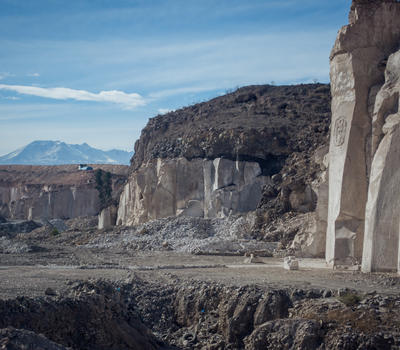
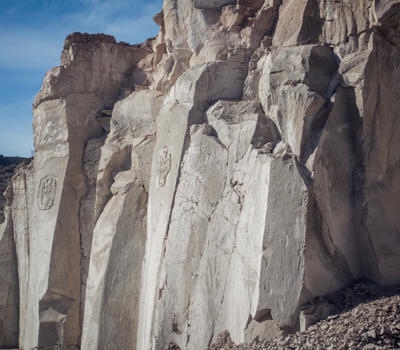
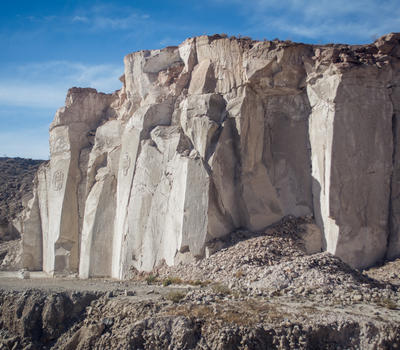
SILLAR QUARRIES
This tour shows where the material that was used for the construction of the historic center of Arequipa comes from and will help you discover why it is called the White City.
Duration: 1.5 hours
Altitude: 2387 masl (7831 fasl)
Maximum: 23°C (73°F) Minimum: 9°C (48°F)
Access Route:
17 km2 (11 mi2) from Arequipa City
Fun for kids
Our guide will pick you up from your hotel to go to the quarries of Sillar, on the outskirts of the city.
Upon arrival, we will see how an artisan stonemason makes the volcanic tuff the sillar blocks (material that was used for the construction of the historic center).
You will be able to participate in the process of making the blocks, with combo and chisel, then you will be able to appreciate and take pictures on the wall of the mega carving on the facade of the church of the company.
Show More
Show Less
MUSIC & ARTS
(INCLUDED)
Below are the activities for each destination:
Cusco
• Cuzquenian Colonial Ceramic Workshop
• Quechua Theatre in a local house
• Ceramic Class (with Pablo Seminario)
• The Pisac Market
Lima
• Afroperuvian Journey
• Peruvian Paso Horse Show
• Typical Dances Show
Show More
Show Less

CUSQUENIAN COLONIAL CERAMIC WORKSHOP
This journey starts with Julio Gutiérrez, a famous craftsman in Peru dedicated to the craftsmanship and the recovery of the Colonial Glass technique, he obtained several prizes and the recognition by the UNESCO and the Ministry of Culture.
Duration: 4hours (approximately)
Altitude: 3399 masl (11156 fasl)
Maximum: 20°C (68°F) Minimum: 4°C (39°F)
Access Route:
3 km (1.8 miles)
16 min in car (from Cusco Main Square)
Fun for kids: From 4 years old
On the Cuzquenian Colonial Ceramic Workshop, you will transform the clay through different processes. First, you will knead the material, then the participant receives an original piece of Julio’s pottery coated in lead-free varnish.
After a brief break that is shared with the artist; you will go to the workshop of “Dorado Colonial Cusqueño” and then work together in the process of the Dorado technique of metal sheets application. After a introduction, you will be given a piece of ceramic, product of a collaborative interpretation between Kutiry (Julio Gutiérrez) and Totemiq Collective, of the traditional “Caballito de Pucará” or “Torito de Pucará”. The pieces which you worked on will go through a drying process.
Show More
Show Less
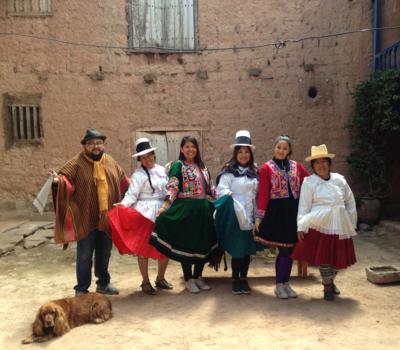
QUECHUA THEATRE IN A LOCAL HOUSE
Be a part of an innovative artistic presentation for those with a passion for learning about new cultures and languages by immersing in them.
Duration: 1 hr
Altitude: 3481 masl (11421 fasl)
Maximum: 20°C (68°F) Minimum: 1°C (34°F)
Access Route:
41 km (25 miles)
1:08 hours by highway (from Cusco)
It begins with a transfer to the small rural town of Maras, known for the magnificent scenery of its salt plans. There you will visit a local house, property of Amílcar del Castillo who has vast experience in Rural Community Tourism.
Learn more about the Quechua origin, a millenary language that is proper of the region which has been preserved over the years by its speakers.
Once you have learned about their language and traditions, you will be able to appreciate it by being a spectator of a short play in Quechua. Undoubtedly, unique experience for travelers from all over the world.
Show More
Show Less
CERAMIC CLASS (WITH PABLO SEMINARIO)
Walk through the Sacred Valley and make a stop at Pablo Seminario’s Ceramic Workshop, where you will observe creations in progress and with luck maybe even meet Pablo Seminario himself as he mainly works in his studio year-round.
Duration: 2.5 hours
Altitude: 2871 masl (9419 fasl)
Maximum: 21°C (70°F) Minimum: 2°C (36°F)
Access Route:
53 km (33 miles)
1:21 hour by highway (from Cusco)
Fun for kids: From 6 years old
*This service requires booking in advance to take the class with the artist Pablo Seminario.
Pablo dedicates his life to the discovery of techniques and designs from ancient Peruvian cultures. Every production of his studio presents a new artistic expression, providing continuity to these cultural inheritances. In his atelier, Pablo Seminario works on the drafts of winged men and magic creatures with crowned heads and round eyes, which resemble traditional pre-Inca pieces.
Inside the working rooms, a group of artisans trained by the family draw and paint cups, vases, and lamps with great accuracy and skill by using long brushes submerged in colored paints. At the end of your visit, you will have the opportunity to even buy one of their unique pieces.
Show More
Show Less
.jpg)
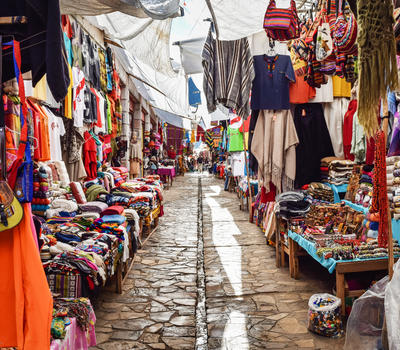
THE PISAC MARKET
Inside of the Sacred Valley of the Incas, lies the town of Pisac which is home to the Pisac Market. In this place of reunión, all artisans of the region get together and exchange or sell their products.
Duration: 1.5 hours
Altitude: 2974 masl (9757 fasl)
Maximum: 18°C (64°F) Minimum: 0°C (32°F)
Access Route:
34 km (21 miles)
54 min by highway (from Cusco)
Originally only opens on Sundays, but due to the increase of tourism in the area during the 20th century, it became increasingly popular to the point that now tends to visitors daily.
The market is a must-visit for travelers looking to immerse themselves in its vibrant atmosphere.
This is an excellent opportunity to share the locals’ customs closely with plenty of time to leisurely roam through the textiles and souvenir sections of the market, exploring and even bartering all the goods and crafts typical of the areas around Cusco.
Show More
Show Less
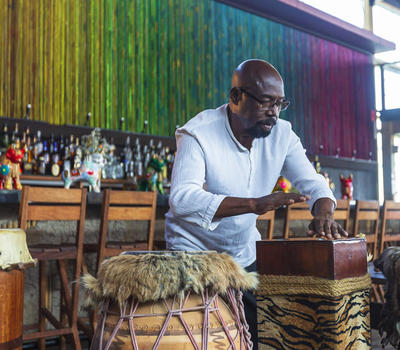
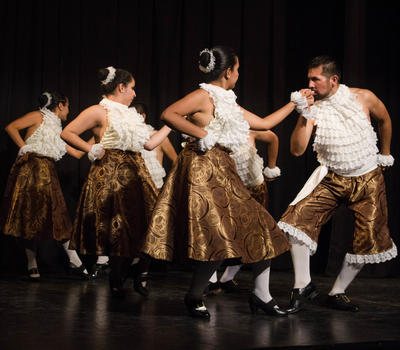
AFROPERUVIAN JOURNEY
The Afroperuvian Journey will take you through afro-peruvian typical dance, oral tradition and history in the Amano Museum which showcases important historical ítems.
Duration: 1 hr
Altitude: 101 masl (331 fasl)
Maximum: 26°C (79°F) Minimum: 14°C (57°F)
Access Route:
21 km (25 miles)
40 min (from Jorge Chavez International Airport)
Fun for kids: From 4 years old
Embark in a 60-minute journey across the history of afro-peruvian culture through the different musical instruments from the coast region: Peruvian cajón, quijada o jawbone, cajita o little box and checo.
An experience full of movement and joy, where brief afro-peruvian dance steps can be learned as well as simple beats of “cajón” and ancient songs.
The experience ends with a typical song and dance starred by the travelers and the cultors. After the experience you will be taken back to your hotel.
Show More
Show Less
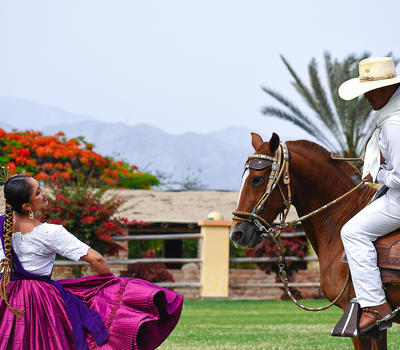
PERUVIAN PASO HORSE SHOW
Today you will be driven to traditional Hacienda Los Ficus, located in the outskirts of Lima in the Valley of Lurin. What a better opportunity to enjoy a traditional Peruvian Paso Horse spectacle than in a place devoted to their breeding.
Duration: 3 hours
Altitude: 9 masl (29 fasl)
Maximum: 15°C (59°F) Minimum: 28°C (82°F)
Access Route:
52.1 km (32 miles)
1h 15min by highway (from Lima International Airport)
Relax and learn first-hand about the history of this particular type of horse. Maybe even enjoy the opportunity of riding the smoothest horse in the world and feel the elegant “paso” walk that resembles a dance.
Marvel at the grace and elegance of the descendants of these horses introduced into Peru by the Spanish in the sixteenth-century. More than 400 years of highly selective breeding have rendered a very unique horse: larger, deeper in the body and wider, high head carriage and front leg lift, smooth to ride and exhibit basic four-beat lateral footfall.
Admire newborns and horses being trained and adult horses showing off all their qualities in their luxurious “apero” outfits, ridden by our “chalanes” in typical garments. Following the exhibition, enjoy a typical countryside lunch.
Show More
Show Less

TYPICAL DANCES SHOW
Peru is sound, flavor and aroma that awakens the senses. More than 3,000 traditional dances and around 500 typical dishes tell the story through costumes and melodies, ingredients and preparation, and they transform into the living legacy of our people.
Duration: 3 hours
Altitude: 64 masl (210 fasl)
Maximum: 15°C (59°F) Minimum: 28°C (82°F)
Access Route:
20.9 km (13 miles)
40 min by highway (from Lima International Airport)
In Peru 84 of the 117 ecosystems in the world coexist. Present in our sea, deserts, mountains and jungle offering us more than 3,000 different varieties of potatoes, 1,200 types of marine species and 50 types of ajíes (chili peppers) these are just some of the products that fill our tables..
We want you to discover our history in a different way through the best touristic show in Lima.
Discover the coast, the mountains, and the jungle through every dish while enjoying the most colorful traditional folkloric dances and explore our country’s culture.
Show More
Show Less
FESTIVITIES
(INCLUDED)
Below, discover our festivals:
• Northern Marinera National Festival
• Virgen de la Candelaria
• Peruvian Paso Horse Contest
• The Lord of Qoylluriti
• Qeswachaca Festival
• The Inti Raymi Celebration
• Virgen de Paucartambo
Show More
Show Less
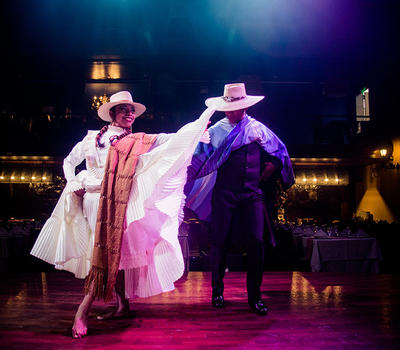
.jpg)
NORTHERN MARINERA NATIONAL FESTIVAL
The Northern Marinera is a typical Peruvian dance very traditional in Peru which represents a couple flirting. The man tries to seduce the woman and finally she decides to accept him. The man can dance with shoes while the woman doesn’t wear them.
Date: Jan 20th to 30th
Altitude: 34 masl (111 fasl)
Maximum: 26°C (79°F) Minimum: 17°C (63°F)
Access Route:
10 km (6 miles)
26 min by Highway (from La Libertad Airport)
For Marinera couples, it is a matter of pride being able to dance on difficult or hot surfaces without losing their style and rhythm. This is achieved with hours of practice to improve their dance technique.
Trujillo City is known as the National Capital of Marinera, it is the place where every year the National Marinera Contest is held since 1960. For around 10 days, all the competitor couples, not only from our country but worldwide, arrive at Trujillo to participate in the different categories. However, the category which causes more excitement and most couple long to win is the Champion of Champions.
You can also enjoy the traditional activities that go over the main streets of the Historical Center of Trujillo.
Show More
Show Less
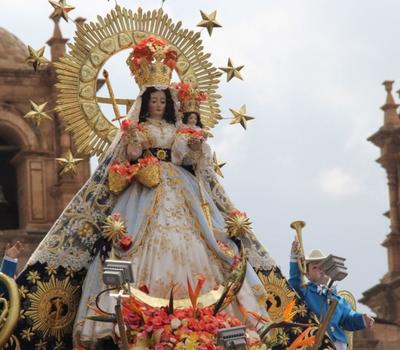
.jpg)
VIRGEN DE LA CANDELARIA
Back in the 1400s, an image of the Virgin Mary was found by two fisherman in the Tenerife coastline (Spain). It was there where the image of the virgin was mixed with the pagan festivity of light where candles were lit in a processional.
Date: Feb 1st to 13th
Duration: Full day
Altitude: 3187 masl (10456 fasl)
Maximum: 18°C (64°F) Minimum: 0°C (32°F)
Access Route:
36 km (22 miles)
3:30 hours by boat (from Puno)
The veneration of this virgin was brought to Peru during conquest times, and this is where the second mixture of cultures took place. Spanish priests decided to give the virgin a sun-like crown and put the moon at her feet; in that way, the Quechua and Aymara people could venerate their sun and moon gods while the Spaniards prayed to the virgin.
Nowadays, the celebration of the Virgen de la Candelaria takes place every February in Puno and thousands of believers accompany her around the streets carrying candles that illuminate the night and their paths.
Traditional dances and music of the area can also be seen in the days surrounding the main celebration.
Show More
Show Less
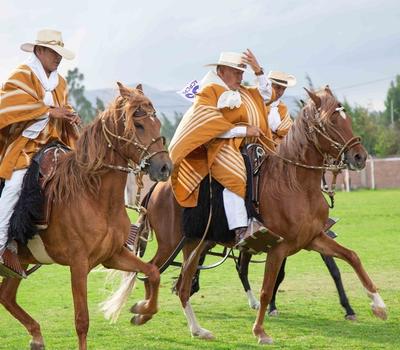
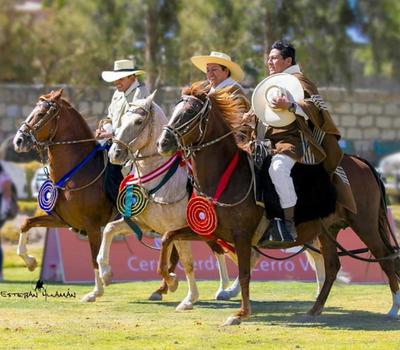
PERUVIAN PASO HORSE NATIONAL CONTEST
Strength, beauty, and rhythm; the Peruvian Paso horse posseses these traits and more. The Peruvian Paso Horse national competition will allow you to witness their majestic and powerful gait.
Date: Apr 05th to 15th
Altitude: 9 masl (30 fasl)
Maximum: 21°C (71.4°F) Minimum: 17°C (62°F)
Access Route:
39 km (24 miles)
45 min by South Panamericana (from Lima)
The competition brings together breeders and horse lovers from all over, with over 700 horses being presented and competing to be considered the best of the best.
Between the months of March and April the feast takes place at a hacienda called Mamacona, located in the Lima province; a place where the tradition of the Peruvian Paso Horse has been preserved and honored for several decades..
Be a part of this celebration and rejoice along with hundreds of locals who, like us, are proud of our most beloved horse breed.
Show More
Show Less
.jpg)
THE LORD OF QOYLLURITI
Fifty-eight days after the Christian celebration of Easter Sunday, the Pilgrimage to the Sanctuary of the Lord of Qoylluriti begins. More than 60,000 people from around Cusco gather to celebrate this festivity.
Date: Anytime in May
Duration: 2 days / 1 night
Altitude: 3150 masl (10335 fasl)
Maximum: 19°C (66°F) Minimum: -3°C (27°F)
Access Route:
105 km (65 miles)
2:12 hours by highway (from Cusco)
Upon a rock lies the figure of the Lord of Qoyulluriti, no other than Andean- Christian representation of Jesus, which is visited every year by locals who venerate it and thank it for the graces it has granted them.
Accompany their journey is a procession towards its sanctuary located on the snow-capped mountain of Sinakara.
Witness the multitude praying and carrying offerings along the way, as fireworks light up the night and colorful miniature handicrafts fill the Alacitas market during the day.
Show More
Show Less
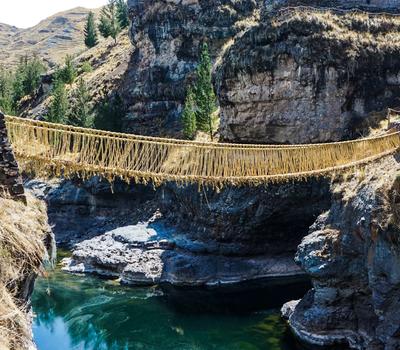
QESWACHACA FESTIVAL
Above the Apurimac River, at 18 meters high, lies the last Inca rope bridge, Qeswachaca, with more than half a millennium. The bridge spans (118 feet / 0,02 miles) and its perfect conditions proof the will of the Andean communities nearby.
Date: Anytime in May
Duration: 2 days / 1 night
Altitude: 3150 masl (10335 fasl)
Maximum: 19°C (66°F) Minimum: -3°C (27°F)
Access Route:
105 km (65 miles)
2:12 hours by highway (from Cusco)
Qeswachaka is the last Inca bridge that is still used in this day and age. This bridge, considered Cultural Heritage by UNESCO, has survived through generations for more than 500 years and maintains its original state thanks to the will and the decision of 4 andean communities that came together to preserve its legacy.
Every year members of the community travel to the bridge and show off their living culture as they repeat techniques and ceremonies of purely Andean origin in order to work on the bridge and prepare for a new cycle.
For three days, the bridge will be renewed. This wonderful event is reproduced year after year, as a paradox in time and showing the authenticity of their culture.
Show More
Show Less
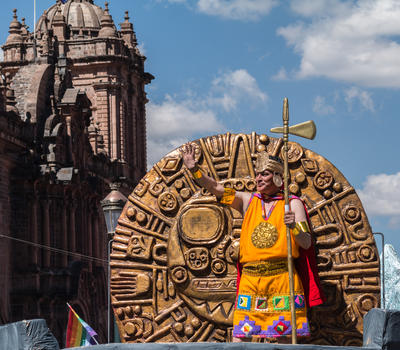
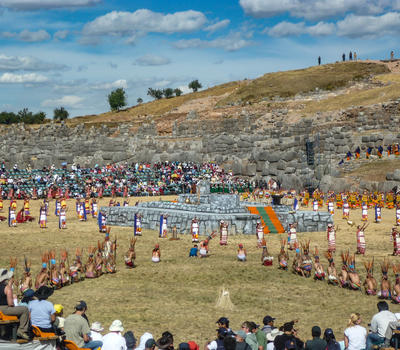
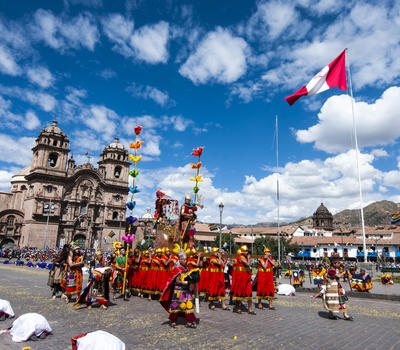
THE INTI RAYMI CELEBRATION
Every year, on the 24th of June, Cusco celebrates the festival of Inti Raymi, the winter solstice in the southern hemisphere. Inti Raymi was the most majestic and greatest festival of the Inca Empire to honor the sun god. Today, this ceremony evokes the splendid Inca ritual.
Date: June 24th
Duration: 8 hours
Altitude: 3700 masl (12139 fasl)
Maximum: 20°C (68°F) Minimum: -1°C (30°F)
Access Route:
4.2 km
15 min by highway (from Cusco)
For more than half a century, it takes place at the fortress of Sacsayhuaman. There, step by step, thousands of actors proudly bring the past alive, giving thanks to sun god. In ancient times, an animal sacrifice was performed.
After the sacrifice, the High Priest had to produce the “Sacred Fire”. Staying in front of the Sun he had to get its rays in a concave gold medallion that contained some soft or oily material in order to produce the fire that had to be kept during next year in the Qorikancha and Aqllawasi.
Once the Inti Raymi were finished, all the attendants were located in the southwestern Plaza sector named “Kusipata” (Plaza del Regocijo) where after being nourished, people were entertained with music and dances.
Show More
Show Less
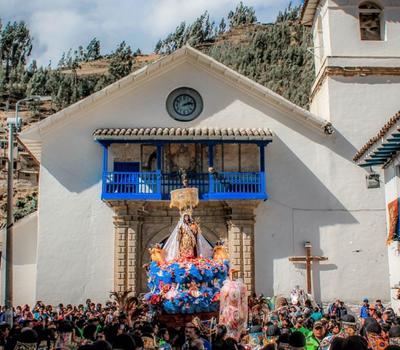
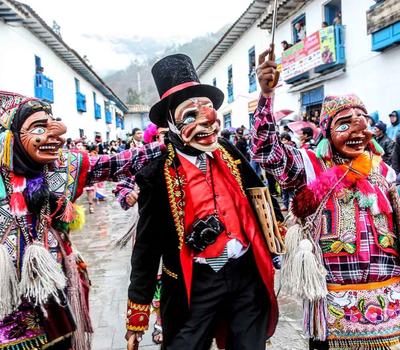
VIRGEN DE PAUCARTAMBO
Along with a traditional dances walks the Virgen de Paucartambo, the Patroness of the Mestizos. Music, choirs that sing in Quechua and troupes that represent passages of the history of Peru accompany her on her journey.
Date: Anytime in July
Duration: 2 days / 1 night
Altitude: 2906 masl (9534 fasl)
Maximum: 22°C (72°F) Minimum: 2°C (36°F)
Access Route:
108 km (67 miles)
2:17 hours by highway (from Cusco)
At night, experience firsthand the burning fireworks that illuminate the skies and put an end to the first day of celebration. The singing and dancing will surround you through the second day, when the Virgin blesses the assistants and drives away the saqras, demons, dancers who perform risky pirouettes on the rooftops trying to tempt the Virgin and the assistants to sin.
The celebration ends the next day where dancers again take to the streets and at night the famous “guerrilla” takes place, simulation of fight between angels, demons and the assistants.
Those who wish to complete the experience can join in an excursion to the Tres Cruces (Three crosses) hill to watch the sunrise.
Show More
Show Less

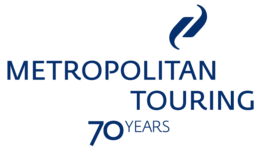

.jpg)




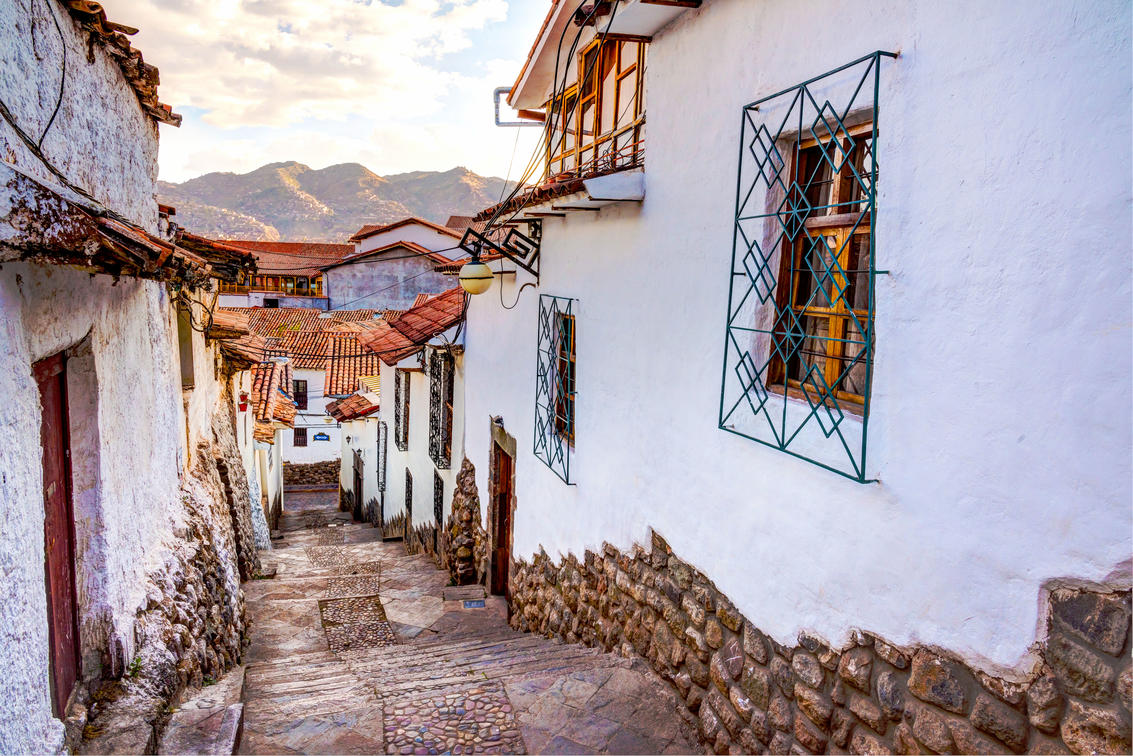








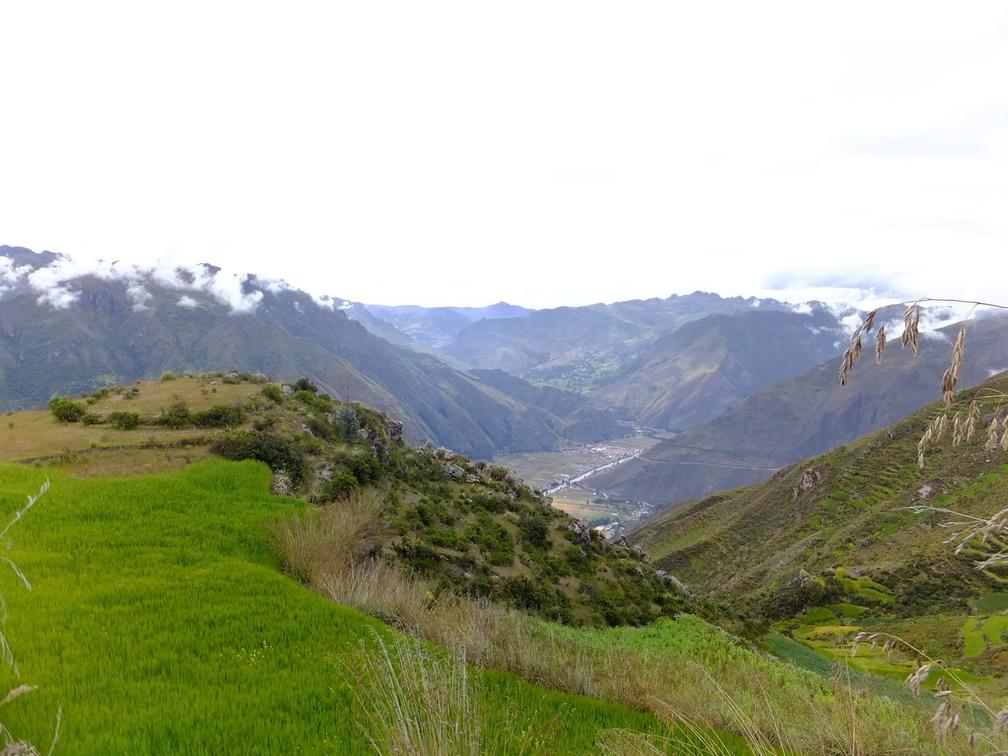
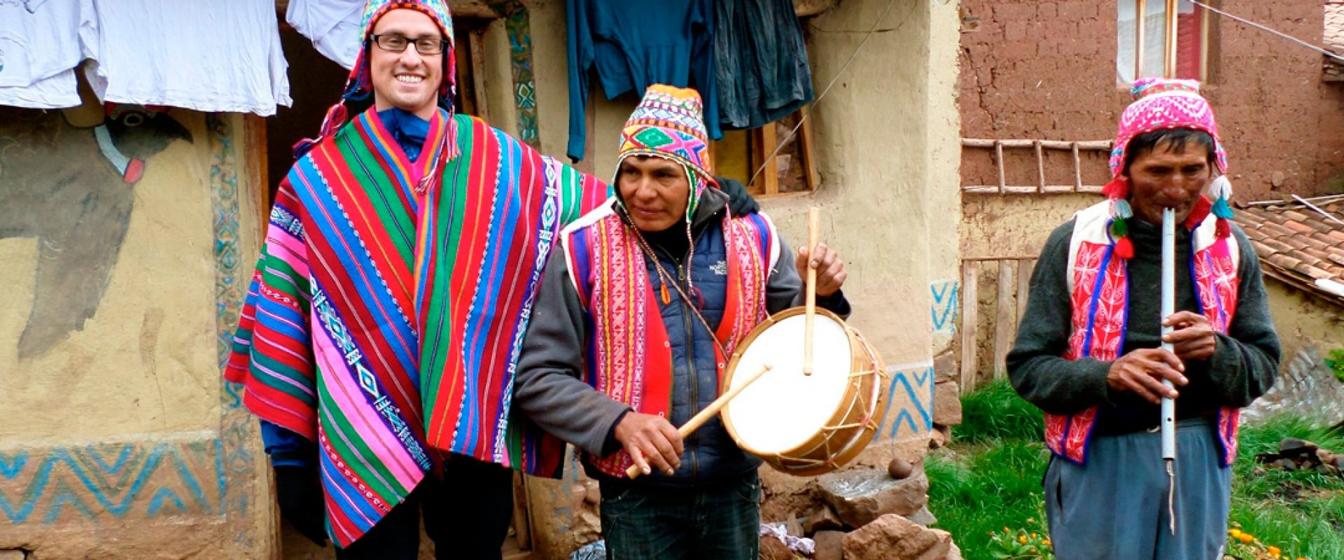





.jpg)


.jpg)
.jpg)

.jpg)

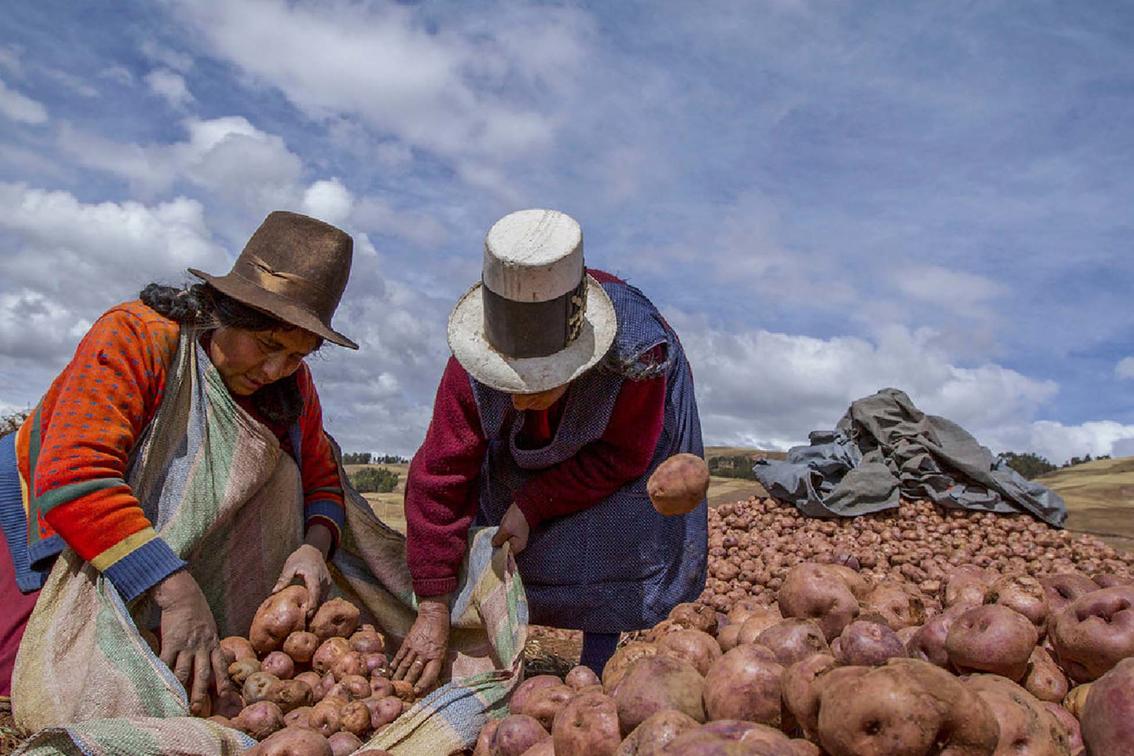




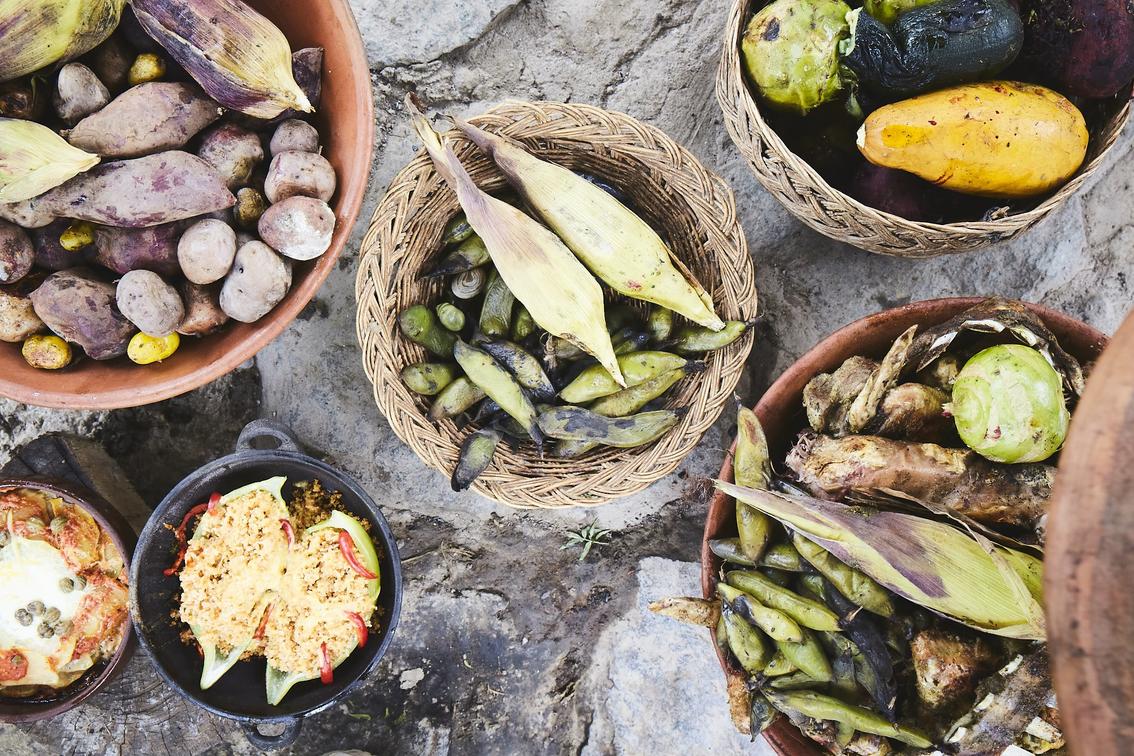














.jpg)
-(1).jpeg)

.jpeg)


.jpeg)


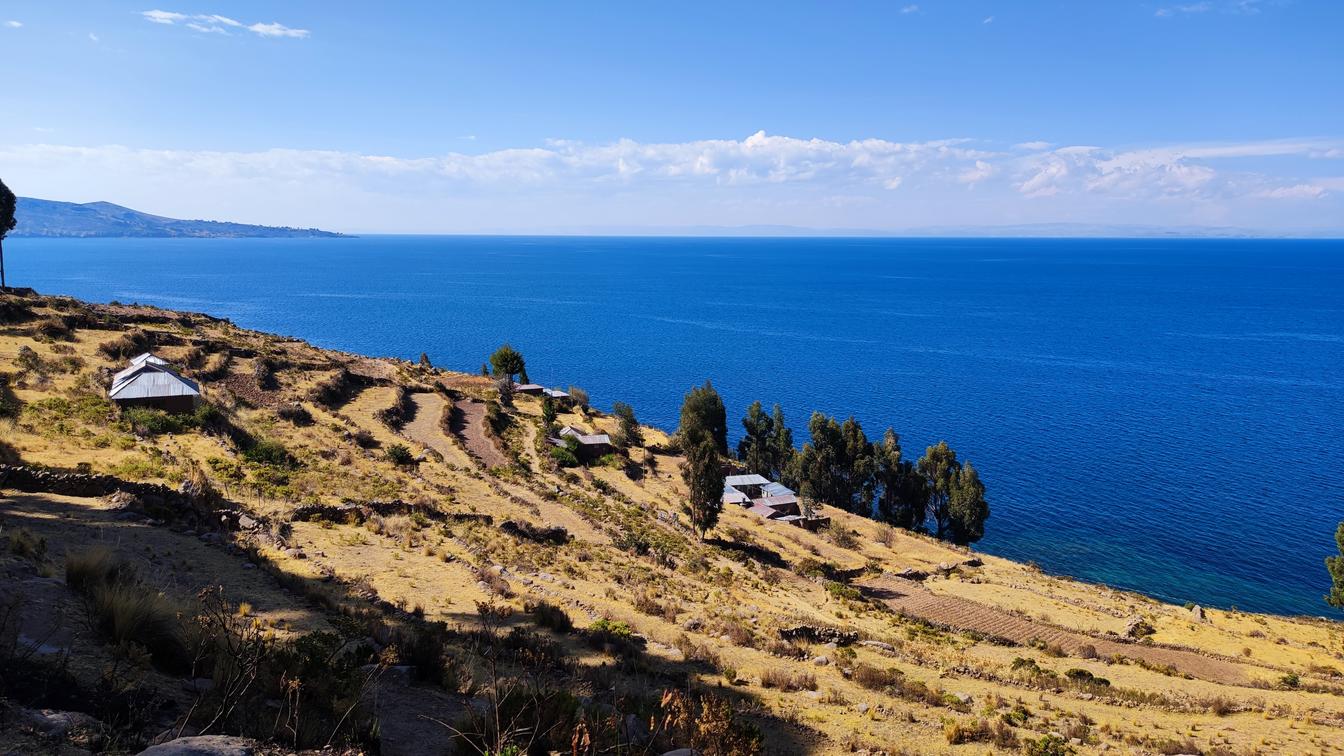




.jpg)

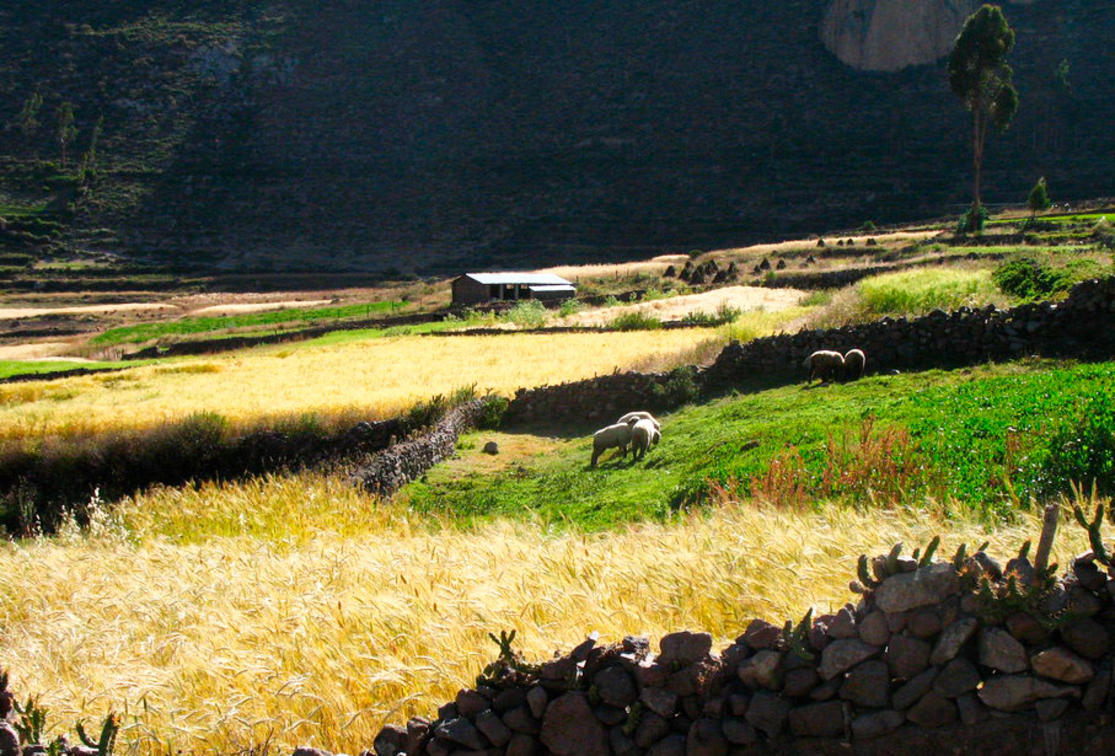





.jpeg)






.jpg)




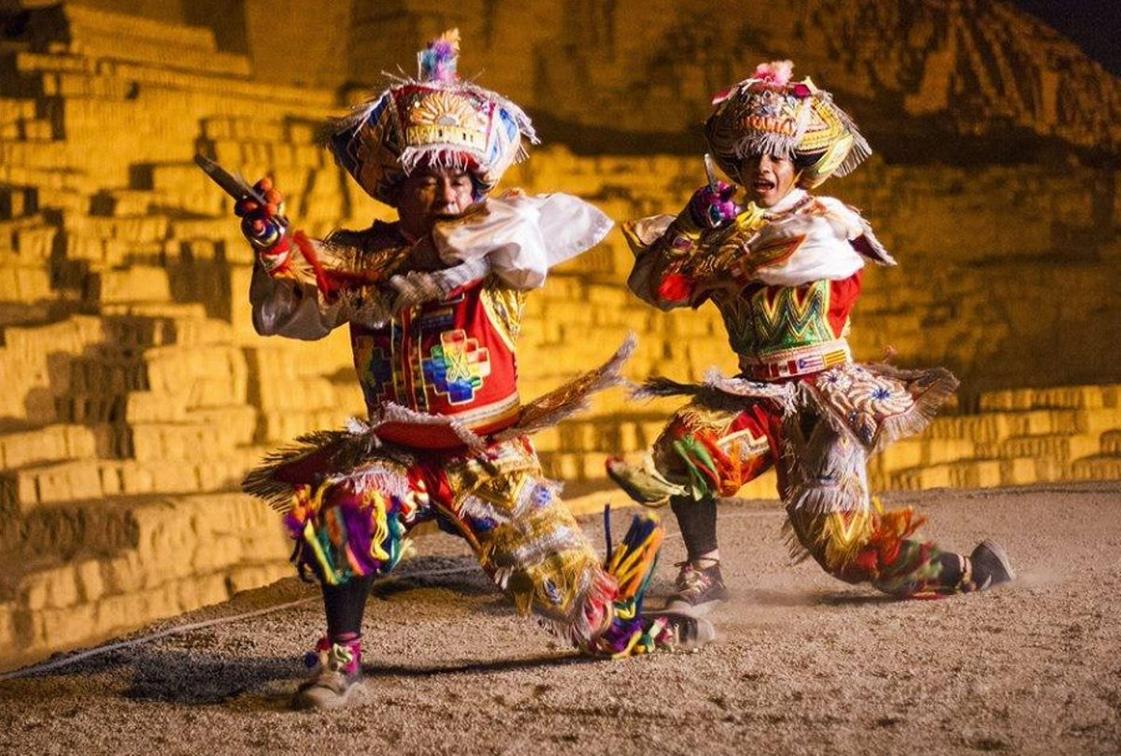

.jpg)

.jpg)


.jpg)






